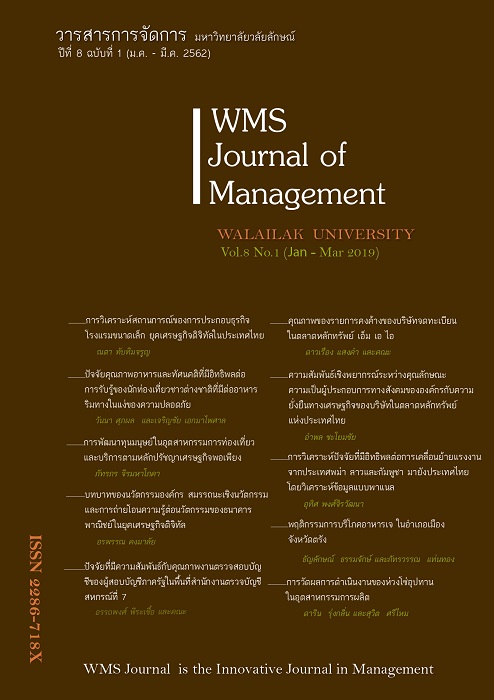Roles of organization innovation, innovative competency, and knowledge transfer on innovation of Thai commercial banks in digital economy
Main Article Content
Abstract
The objective of this study was to examine the influences of organization innovation, innovative competency, and knowledge transfer on innovation of Thai commercial banks in digital economy. This research is quantitative in nature; data were collected through a questionnaire, which was distributed to a sample of respondents from the top five commercial banks in Thailand. Eventually, 340 usable questionnaires were collected (a 68% response rate). Structural equation modelling (SEM) was used for data analysis. The research results indicate that organization innovation has an indirect positive influence on the competitive advantage of Thai commercial banks. Additionally, innovative competency and knowledge transfer simultaneously influence on innovation of Thai commercial banks. This research demonstrated that innovation of Thai commercial banks is a combination of product innovation, process innovation, and marketing innovation.
Article Details
References
Baryniene, J. & Dauknyte, B. (2015). Creativity as the main factor for organizations’ success. Theoretical approach. European Integration Studies, 9, 235-243.
Berdykulova, G.M.K., Sailov, A. I. U., Kaliazhdarova, S.Y.K., & Berdykulov, E.B.U. (2014). The Emerging digital economy: Case of Kazakhstan. Procedia - Social and Behavioral Sciences, 109(2014), 1287-1291.
Blumenberg S., Wagner, H-T., & Beimborn, D. (2009). Knowledge transfer processes in IT outsourcing relationships and their impact on shared knowledge and outsourcing performance. International Journal of Information Management, 29(5), 342-352.
Bolı´var-Ramos, M.T., Garcı´a-Morales, V.J., & Garcı´a-Sa´nchez, E. (2012). Technological distinctive competencies and organizational learning: Effects on organizational innovation to improve firm performance. Journal of Engineering and Technology Management, 29(3), 331–357.
Caiazza, R., Richardson, A., & Audretsch, D. (2015). Knowledge effects on competitiveness: from firms to regional advantage. The Journal of Technology Transfer, 40(6), 899-909.
Cronbach, L. (1970). Essential of psychology testing (3rd ed.). NY: Harper and Row, Publishers.
Cummingsa, J., & Teng, B-S. (2003). Transferring R&D knowledge: The key factors affecting knowledge transfer success. Journal of Engineering and Technology Management, 20(1-2), 39-68.
Distanont, A., Haapasalo, H., Vaananen, M, & Lehto, J. (2012). The engagement between knowledge transfer and requirements engineering. International Journal of Management, Knowledge and Learning, 1(2), 131-156.
Duan, Y., Xu, X., & Fu, Z. (2006). Understanding transnational knowledge transfer. The 7th European Conference on Knowledge Management, Budapest, Hungary, Academic Conference.
Domingo, S. (2010). Building Competitive Advantage Through Functional-Level Strategy. Retrieved from https://domingoesalazarg.wordpress.com/2010/11/08/building-competitive-advantage-through-functional-level-strategy/.
Hair, J. F., Tatham, R. L., Rolph E.A., & Black, W. C. (1998). Multivariate data analysis (5th ed.). NJ: Prentice-Hall.
Hill, C.W.L., & Jone, G.R. (2003). Strategic management: an integrated approach. NY:Houghton Mifflin Company.
Kadar, M., Moise, I.A., & Colomba, C. (2014). Innovation management in the globalized digital society. Procedia - Social and Behavioral Sciences, 143(2104), 1083-1089.
Kogut, B., & Zander, U. (1992). Knowledge of the firm, combinative capabilities, and the replication of technology. Organization Science, 3(3), 383-397.
Lei, D., Hitt, M.A., & Bettis, R. (1996). Dynamic core competences through meta-learning and strategic context. Journal of Management, 22(4), 549–569.
Liao, S-H, Chen, C-C, Hu, D-C, Chung, Y-C, & Yang, M-J. (2016). Developing a sustainanle competitive advantage: absorptive capacity, knowledge transfer and organizational learning. The Journal of Technology Transfer, 1-20.
Lindeman, R. H., Merenda, P. F., & Gold, R. Z. (1980). Introduction to bivariate and multivariate analysis. Glenview, IL: Scott, Foresman.
Lyer, D.N., Sharp, B.M., & Brush, T.H. (2017). Knowledge creation and innovation performance: an exploration of competing perspectives on organizational systems. Universal Journal of Management, 5(6), 261-270.
Lynn, M. R. (1986). Determination and quantification of content validity. Nursing Research, 35, 382 - 385.
McKeown, M. (2008). The Truth About Innovation. London, England: Prentice Hall.
Nonaka, I., Toyama, R., & Konno, N. (2000). SECI, Ba and Leadership: A Unified Model of Dynamic Knowledge Creation. Long Range Planning, 33, 5-38.
Nonaka, I. (1994). A dynamic theory of organizational knowledge creation. Organization Science, 5(1), 14-37.
Nunnally, J. C. (1978). Psychometric theory. NY: McGraw Hill.
Oruç, O.E., & Tatar, C. (2017). An investigation of factors that affect internet banking usage based on structural equation modeling. Computers in Human Behavior, 66, 232-235.
Racela, O. C. (2014). Customer orientation, innovation competencies, and firm performance: A proposed conceptula model. Procedia - Social and Behavioral Scince, 148, 16-23.
Schumpeter, J. (1975). Capitalism, Socialism, and Democracy. NY: Harper.
Szulanski G. (2000). The Process of knowledge transfer: A diachronic analysis of stickiness. Organizational Behavior and Human Decision Processes, 82(1), 9-27.
The Stock Exchange of Thailand. (2016). SET awards 2016 criteria. Bangkok, Thailand: The Stock Exchange of Thailand.
Tidd, Bessant, & Pavitt, (2005). Managing Innovation: Integrating Technological, Market and Organizational Change. London, England, Wiley.
Tippins, M.J., & Sohi, R.S. (2003). IT Competency and Firm Performance: Is Organizational Learning a Missing Link?. Strategic Management Journal, 24, 745-761.
Vila, L. E., Perez, P. J., & Morillas, F. G. (2012). Higher education and the development of competencies for innovation in the workplace. Management Decision, 50(9), 1634-1648.
Vila, L.E., Perez, P.J., & Coll-Serrano, C. (2014). Innovation at the workplace: Do professional competencies matter?. Journal of Business Research, 67(5), 752–757.
Yıldırım, N., Karaca, A., Cangur, S., Acıkgoz, F., & Akkus, D. (2017). The relationship between educational
stress, stress coping, self-esteem, social support, and health status among nursing students in Turkey: A structural equation modeling approach. Nurse Education Today. 48, 33-39.
Zhengwei, M., Guanglin, P., Xiucheng, D., & Chi, C. (2017). The situation analysis of shale gas development in China-based on Structural Equation Modeling. Renewable and Sustainable Energy Reviews, 67, 1300–1307.


